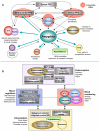Linking molecules to mood: new insight into the biology of depression
- PMID: 20843874
- PMCID: PMC3031089
- DOI: 10.1176/appi.ajp.2009.10030434
Linking molecules to mood: new insight into the biology of depression
Abstract
Major depressive disorder is a heritable psychiatric syndrome that appears to be associated with subtle cellular and molecular alterations in a complex neural network. The affected brain regions display dynamic neuroplastic adaptations to endocrine and immunologic stimuli arising from within and outside the CNS. Depression's clinical and etiological heterogeneity adds a third level of complexity, implicating different pathophysiological mechanisms in different patients with the same DSM diagnosis. Current pharmacological antidepressant treatments improve depressive symptoms through complex mechanisms that are themselves incompletely understood. This review summarizes the current knowledge of the neurobiology of depression by combining insights from human clinical studies and molecular explanations from animal models. The authors provide recommendations for future research, with a focus on translating today's discoveries into improved diagnostic tests and treatments.
Figures





References
-
- Evans DL, Charney DS, Lewis L, Golden RN, Gorman JM, Krishnan KR, Nemeroff CB, Bremner JD, Carney RM, Coyne JC, Delong MR, Frasure-Smith N, Glassman AH, Gold PW, Grant I, Gwyther L, Ironson G, Johnson RL, Kanner AM, Katon WJ, Kaufmann PG, Keefe FJ, Ketter T, Laughren TP, Leserman J, Lyketsos CG, McDonald WM, McEwen BS, Miller AH, Musselman D, O’Connor C, Petitto JM, Pollock BG, Robinson RG, Roose SP, Rowland J, Sheline Y, Sheps DS, Simon G, Spiegel D, Stunkard A, Sunderland T, Tibbits P, Jr., Valvo WJ. Mood Disorders in the Medically Ill: Scientific Review and Recommendations. Biol Psychiatry. 2005;58(3):175–89. - PubMed
-
- Lopez AD, Murray CC. The Global Burden of Disease, 1990-2020. Nat Med. 1998;4(11):1241–3. - PubMed
-
- Diagnostic and Statistical Manual of Mental Disorders. 4th Edition American Psychiatric Publishing; Washington, D.C.: 2000.
-
- Hercher C, Turecki G, Mechawar N. Through the Looking Glass: Examining Neuroanatomical Evidence for Cellular Alterations in Major Depression. J Psychiatr Res. 2009;43(11):947–61. - PubMed
Publication types
MeSH terms
Substances
Grants and funding
LinkOut - more resources
Full Text Sources
Other Literature Sources

